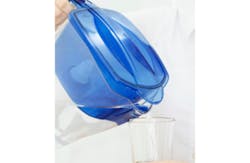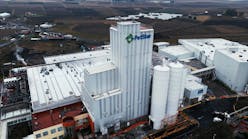Activated carbon is one of the most widely used filter mediums in the world. Most average consumers know what a carbon filter is, perhaps acquainted with them through an inexpensive refrigerator pitcher.
But, there is a lot more to carbon than that pitcher lets on. Carbon can be made in many different ways and each type is best suited to a different application. Choosing the correct type can make a difference in carbon's lifespan and system effectiveness. Pretreatment technologies and even carbon regeneration can significantly affect the lifespan of your carbon. Building a well thought out system around carbon can save you significant time and money and better achieve your filtration objectives.
The carbon basics
“Activated carbon is probably one of the oldest filter media used in the process of filtration. Since 400 BC, it has been used to purify water and remove health hazardous chemicals and unpleasant odors,” says Omitha Devendra, sales engineer at Carbon Activated Corp.
Robert Potwora, technical director of Carbon Resources and chairman of ASTM International D28 Technical Committee on Activated Carbon, calls activated carbon the universal absorbent.
According to Jenalle Brewer, marketing manager, specialty products at Calgon Carbon Corporation; Andy McClure, product manager at Jacobi Carbons Inc.; Potwora; and Devendra carbon is effective at removing many contaminants, including:
- Residual chlorine and monochloramine
- Taste and odor causing organic contaminants
- Volatile organic compounds (VOCs)
- Trihalomethanes (THMs) and other halocarbons
- Endocrine disrupting compounds (pharmaceuticals, personal care products, etc.)
- Chloramine, hydrogen sulfide and hydrogen peroxide (removed by catalytic carbons).
Because of its versatility, carbon can be used in a number of applications, according to our experts, to purify: Air; drinking water; wastewater; food and beverages; and pharmaceuticals.
In addition to its many applications, activated carbon is efficient and cost effective, says Brewer.
“Activated carbon is unique in that it has among the highest amount of surface area per unit volume of any adsorbent known to man,” adds McClure. “One gram of carbon will typically have over 1,000 square meters of surface area. Another benefit of carbon is that it is a very forgiving technology; when influent contaminant concentration levels vary, activated carbon can still meet treatment objectives and provide a very consistent effluent quality.”
Carbon comes in many forms, from granular activated carbon to carbon block, and can be made from a variety of materials.
“Activated carbon can be produced from any material with adequate carbon content,” says Brewer. “The precursors help to define the properties of the final activated carbon product.”
According to our experts, carbon can be made from coconut shell, various grades of coal or wood. Coconut shell carbons typically have a high percentage of small micropores and are excellent for VOC adsorption from groundwater streams, McClure says.
“A coconut based activated carbon is very microporous, which means that the carbon has many adsorption pores and fewer transport pores,” Brewer explains. “Coconut carbons are better for smaller molecules which will not be sterically hindered by the lack of transport pores.”
Coconut shell carbons are also very pure, and can easily meet stringent purity requirements in place in various parts of the country, Potwora adds.
Carbon can also be made from bituminous or anthracite coal.
“Coal based carbons typically have a broad pore structure of both small micropores and medium sized mesopores, and are suitable for both surface water applications and wastewater treatment,” McClure says.
Carbon derived from bituminous coal and coconut shells is used most frequently due to its capability to remove a large range of contaminants and impurities in organic and inorganic form, informs Devendra.
“Bituminous coal has a good blend of both transport pores and adsorption pores, which makes it an ideal choice for a variety of applications,” adds Brewer.
Carbon made from wood has a high percentage of larger macropores that make it ideal for removal of color bodies and other large organics such as humic acids from water, notes McClure.
Brewer adds that wood based carbon has a large number of transport pores and lower abrasion resistance.
“The different types of raw materials have a direct impact upon the activated carbon’s properties,” Potwora says, making a difference in overall filtration system effectiveness.
The key to longevity
There are many steps you can take to extend the life of your activated carbon, including choosing the correct type for your application, installing and caring for the system correctly and using the correct pretreatment options.
After knowing the carbon basics, it’s important to research exactly which type of carbon will best fit your application.
“Carbons made from different raw materials possess vastly different pore size ranges, which lend themselves toward certain applications,” McClure explains. “For example, using a wood based carbon for groundwater treatment to remove trace (ppb) levels of VOC’s will likely result in a very short bed life, as these carbons do not possess the micropore structure needed in this application.”
Another important factor to consider is carbon installation and system care, which are two often overlooked details that can make a big difference.
Potwora tips that backwashing activated carbon systems filtering free chlorine or monochloramine daily or weekly will extend the life of the carbon, while McClure emphasizes the importance of properly installing the carbon.
Proper installation involves soaking the carbon in water for 24 hours to remove entrained air and properly backwashing prior to putting it in the system.
“Most of the time, a bed that breaks through prematurely has not been properly prepared for service in this manner,” continues McClure. “Also, operating two carbon beds in series, and monitoring for breakthrough between the two beds, allows for the lead bed to be operated as close to its saturation capacity as possible, extending bed life.”
Another important step is to build a system that supports long carbon life, including pretreatment components.
“While activated carbon can act as a physical filter, it is best suited to act as an adsorbent for dissolved organics, not the filtration of solids,” says McClure. “The general rule of thumb is that carbon can filter out particles down to 10 microns in size; if a stream contains a significant amount of suspended solids larger than this size, filtration ahead of the carbon bed will help to improve its service life.”
“Preceding a GAC bed with a multi-media filter or other mechanical filtration such as a cartridge filter will keep suspended solids off of the carbon bed and allow it to be principally an adsorption bed,” adds Matthew Adomaitis, marketing manager, industrial and food business unit, Calgon Carbon Corporation. “A typical 12×40 mesh GAC bed will remove particles as small as 12 to 15 microns so it is advantageous to remove larger particles such as those before the GAC.”
In addition to proper pretreatment, mesh size and water quality affect carbon lifespans.
Mesh size establishes the range of particle sizes that can impact operating conditions, including pressure drop, filtration capabilities, backwash rate requirements and the rate of adsorption of contaminants, according to Brewer.
“Another aspect of water quality which can have a profound effect on GAC bed performance is the Langelier Scaling Index or LSI,” adds Adomaitis. “The water feeding the adsorber should not be on the corrosive side as it will attack the piping system. Water on the scaling side will have the potential to occlude the granules and even bridge across the granules, resulting in excessive pressure drop and even channeling.”
Starting over with reactivation
Despite all efforts, carbon for any system and application will eventually be spent.
“Activated carbon, having gone through the process of filtration, eventually loses its adsorption efficiency. This happens when the pore structure of the carbon is too full to adsorb any more impurities. At this point, the carbon is typically deemed spent, and would need replacing. The spent carbon is typically discarded,” explains Devendra.
But, there is another option: Reactivation. Reactivation uses a high-temperature thermal process that destroys the adsorbed organic compounds and restores the adsorptive capacity of the carbon, according to Adomaitis. Up to 95 percent of the virgin activated carbon can be recovered and blended with new virgin carbon.
Carbon reactivation is most applicable to larger commercial, municipal or industrial operations. A typical residential POE filter will not contain enough spent carbon for reactivation.
According to EPA regulations, spent carbon must be analyzed for hazardous content before being regenerated and the regeneration must take place in a NSF Regeneration Facility in order for the end product to be NSF Certified for drinking water purposes, Devendra explains. Reactivated carbon is most suitable for non-potable applications like wastewater treatment.
No matter your application, activated carbon is a smart choice for filtration systems. Its many types and uses make it one of the most widely used filtration mediums in the industry.


